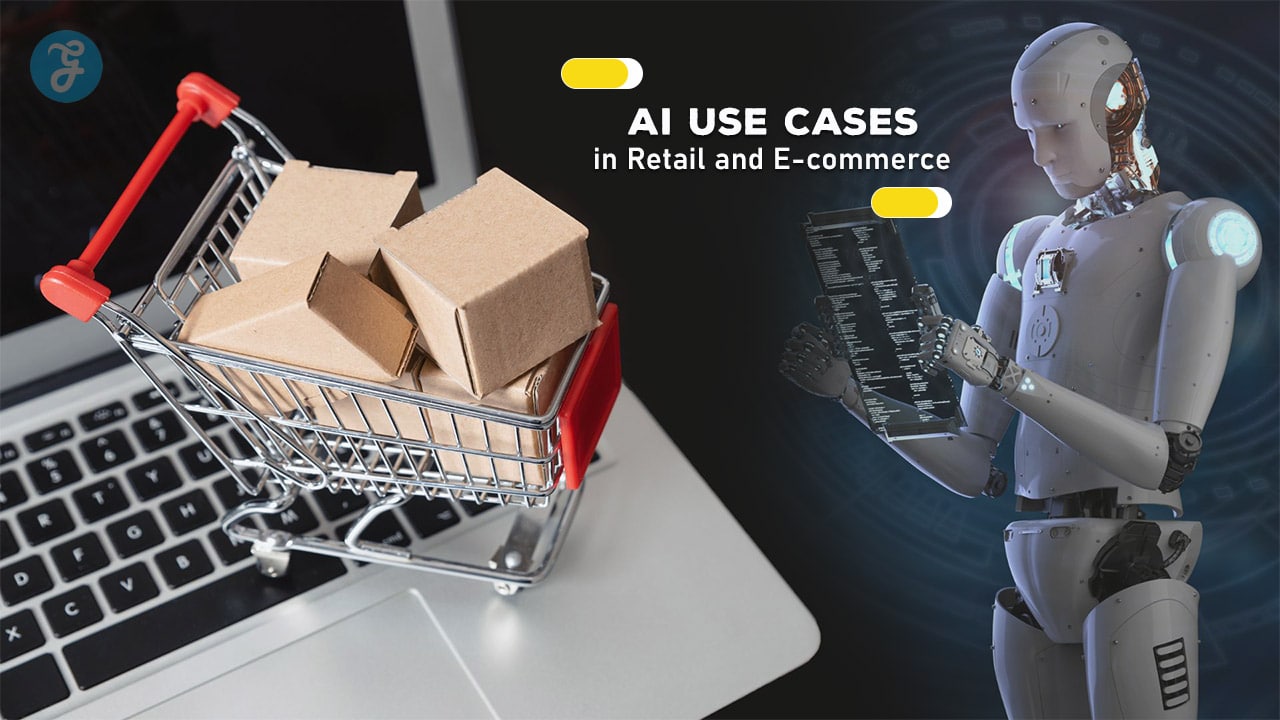Artificial Intelligence (AI) is reshaping industries across the globe, and the retail and e-commerce sectors are at the forefront of this transformation.
From enhancing customer experiences to optimizing backend operations, AI has revolutionized how businesses interact with consumers and manage their processes.
Retailers and e-commerce platforms now rely on AI to stay competitive, increase revenue, and provide better services.
In this article, we’ll explore 15 key AI use cases in retail and e-commerce that are redefining the landscape of shopping and business operations.
1. Personalized Product Recommendations
AI-driven personalized recommendations have become a cornerstone of modern e-commerce.
By analyzing individual customer behavior, purchase history, and preferences, AI can suggest products that are tailored to each shopper’s unique tastes.
Personalized product recommendations enhance customer satisfaction and significantly drive sales.
How It Works:
AI uses machine learning algorithms to track and analyze customer behavior, such as browsing history, past purchases, and even social media engagement.
The system then uses this data to predict which products the customer is most likely to be interested in.
As the customer continues to interact with the platform, the AI refines its recommendations in real-time.
Real-World Examples:
- Amazon:
One of the most well-known examples of AI-powered product recommendations, Amazon’s recommendation engine accounts for a large percentage of its revenue.
The platform uses AI to suggest complementary products, cross-sell related items, and recommend new products based on a user’s browsing and purchasing habits.
- Netflix and Spotify:
While not retail-specific, these platforms are prime examples of AI-driven recommendations.
Netflix recommends movies and shows based on viewing history, while Spotify curates playlists based on listening habits, providing a personalized experience.
Benefits:
- Increased Conversion Rates:
Personalized recommendations are more likely to lead to purchases because they target individual interests and needs.
- Larger Average Order Value:
By recommending complementary or higher-priced products, AI can increase the total value of a customer’s purchase.
- Improved Customer Experience:
Shoppers appreciate tailored suggestions, making them more likely to return to the platform.
2. AI-Powered Chatbots for Customer Support
AI-powered chatbots are revolutionizing customer service by providing instant responses to customer inquiries.
These virtual assistants can handle a wide range of customer interactions, from answering simple questions to assisting with product searches and tracking orders.
They reduce the burden on human customer service teams and ensure that customers receive assistance at any time, day or night.
How It Works:
Chatbots use natural language processing (NLP) and machine learning to understand and respond to customer queries.
As customers interact with the chatbot, the AI continually learns and improves its responses.
For more complex queries, chatbots can escalate the issue to human agents while gathering relevant information to streamline the process.
Real-World Examples:
- Sephora:
Sephora’s chatbot on Facebook Messenger helps customers find products, provides beauty tips, and even books in-store appointments.
- H&M:
H&M uses chatbots to assist customers in finding the right clothing styles based on their preferences, offering outfit recommendations and personalized styling tips.
Benefits:
- 24/7 Availability:
AI chatbots provide round-the-clock service, ensuring customers can get help whenever they need it.
- Cost Efficiency:
Automating customer service with AI chatbots reduces the need for large customer support teams, lowering operational costs.
- Improved Response Times:
Chatbots provide immediate responses, reducing customer wait times and improving overall satisfaction.
3. Dynamic Pricing Strategies
AI-powered dynamic pricing allows retailers and e-commerce platforms to adjust prices in real-time based on factors such as demand, competitor pricing, and market trends.
By continuously analyzing data, AI can recommend price adjustments that maximize profit margins while remaining competitive in the market.
How It Works:
AI algorithms analyze a wide range of data points, including competitor prices, customer demand, inventory levels, and even external factors like weather or holidays.
Based on this analysis, the system suggests optimal pricing strategies that can change multiple times a day to reflect market conditions.
Real-World Examples:
- Uber:
Uber uses dynamic pricing, or “surge pricing,” to adjust fares based on demand.
During periods of high demand, prices increase to balance the supply of drivers with the number of ride requests.
- Amazon:
Amazon’s dynamic pricing algorithm adjusts the prices of products in real-time, ensuring that they remain competitive while maximizing sales and profit margins.
Benefits:
- Increased Profitability:
AI ensures that prices are optimized for profitability, adjusting based on real-time market conditions.
- Competitive Edge:
By constantly monitoring competitor prices, AI helps retailers stay competitive and retain customers.
- Flexibility:
Dynamic pricing allows businesses to respond quickly to changes in demand, maximizing revenue during peak times.
4. Inventory Management and Demand Forecasting
Managing inventory effectively is crucial to maintaining profitability in retail and e-commerce.
AI improves inventory management by forecasting demand, ensuring that businesses have the right products in stock at the right time.
his reduces the risks of overstocking or stockouts, which can lead to lost sales and wasted resources.
How It Works:
AI systems analyze historical sales data, customer behavior, market trends, and external factors like seasonality to predict future demand for products.
This helps businesses maintain optimal inventory levels, reducing excess stock and ensuring that popular products are always available.
Real-World Examples:
- Zara:
Fast fashion giant Zara uses AI to predict customer demand and manage its supply chain efficiently, reducing lead times and ensuring that stores are stocked with the most popular items.
- Walmart:
Walmart employs AI to track customer purchasing patterns and optimize its supply chain.
The system predicts demand fluctuations, allowing for more efficient restocking.
Benefits:
- Reduced Inventory Costs:
AI helps businesses avoid overstocking, reducing storage costs and minimizing losses due to unsold inventory.
- Improved Stock Availability:
AI ensures that businesses can meet customer demand by accurately predicting which products will be in high demand.
- Increased Efficiency:
Automated inventory management saves time and resources, allowing businesses to focus on growth.
5. AI-Driven Visual Search
Visual search is becoming an increasingly popular feature in e-commerce, particularly in fashion and home décor.
Instead of using text-based queries, customers can upload images or use their camera to find similar products online.
AI-powered visual search technology uses image recognition to match the customer’s input with products in the retailer’s inventory, making shopping more intuitive and convenient.
How It Works:
AI visual search engines use machine learning and image recognition algorithms to analyze the features of a product in a photo—such as color, pattern, and texture—and match them with similar items in the retailer’s catalog.
Real-World Examples:
- Pinterest Lens:
Pinterest’s visual search tool allows users to take photos of real-world objects and receive product suggestions based on the image.
- ASOS:
Fashion retailer ASOS offers a visual search feature in its app, allowing users to upload photos of clothing they like and find similar products within the ASOS catalog.
Benefits:
- Improved Customer Experience:
Visual search makes it easier for customers to find products that match their preferences, even if they don’t know the exact name of the item.
- Higher Conversion Rates:
Customers are more likely to complete a purchase when they can quickly and accurately find products that meet their needs.
- Appeal to Visual Shoppers:
Visual search caters to customers who are more inclined to shop based on visual aesthetics rather than text-based searches.
6. Voice-Activated Shopping Assistants
Voice commerce is gaining popularity as AI-powered voice assistants like Amazon’s Alexa, Google Assistant, and Apple’s Siri become more integrated into everyday life.
These voice-activated shopping assistants allow customers to browse products, place orders, and manage their shopping lists using voice commands, offering a hands-free shopping experience.
How It Works:
Voice-activated shopping assistants use natural language processing (NLP) and machine learning to interpret spoken commands.
They can assist with product searches, provide recommendations, place orders, and even track shipments, all through simple voice interactions.
Real-World Examples:
- Amazon Alexa:
Alexa users can order products directly from Amazon using voice commands.
Alexa can also recommend products based on previous purchases and shopping habits.
- Google Assistant:
Google’s voice assistant allows users to shop from a range of retailers by speaking commands, making the shopping experience more convenient.
Benefits:
- Convenience:
Voice commerce enables customers to shop hands-free, making it especially useful in situations where using a device is impractical, such as cooking or driving.
- Faster Transactions:
Customers can place orders quickly without having to navigate through multiple screens or type queries.
- Improved Accessibility:
Voice assistants make online shopping more accessible for people with disabilities or those who prefer not to use a screen.
7. Customer Sentiment Analysis
Customer sentiment analysis is an AI-powered tool that helps retailers gauge how customers feel about their products, services, and overall brand.
By analyzing customer reviews, social media posts, and other forms of feedback, AI can determine whether customer sentiment is positive, negative, or neutral.
This information allows businesses to make informed decisions about product development, marketing, and customer service.
How It Works:
Sentiment analysis tools use natural language processing (NLP) to interpret the emotions behind customer feedback.
These AI systems can process large volumes of unstructured data, such as social media comments or product reviews, to identify patterns and trends in customer opinions.
Real-World Examples:
- Coca-Cola:
Coca-Cola uses AI-powered sentiment analysis to monitor customer feedback on social media, helping the company identify emerging trends and address potential issues before they escalate.
- Nike:
Nike uses AI sentiment analysis to track customer feedback on new product launches and adjust marketing strategies accordingly.
Benefits:
- Improved Customer Experience:
By understanding customer sentiment, retailers can address negative feedback, improve products, and enhance the overall shopping experience.
- Brand Reputation Management:
AI enables businesses to monitor their brand’s reputation in real-time and take proactive steps to mitigate any negative sentiment.
- Data-Driven Decision Making:
Sentiment analysis provides actionable insights that can inform product development, marketing, and customer service strategies.
8. AI-Powered Fraud Detection
As e-commerce grows, so does the risk of fraudulent transactions.
AI is increasingly being used to detect and prevent fraud by analyzing transaction patterns and identifying anomalies in real-time.
AI-driven fraud detection systems help protect businesses and customers from financial losses while ensuring a secure shopping environment.
How It Works:
AI fraud detection systems use machine learning algorithms to analyze transaction data, looking for patterns that may indicate fraudulent activity.
These systems can flag suspicious transactions for further investigation or block them altogether, depending on the level of risk.
Real-World Examples:
- PayPal:
PayPal uses AI to monitor transactions and detect fraudulent activity.
Its AI-driven system continuously learns from data to improve its ability to identify potentially fraudulent transactions.
- Stripe:
Stripe, a payment processing platform, employs AI to detect unusual patterns in payment data, helping to prevent fraud in real-time.
Benefits:
- Enhanced Security:
AI-powered fraud detection helps prevent unauthorized transactions, protecting both retailers and customers from financial loss.
- Reduced Chargebacks:
By detecting fraudulent transactions early, businesses can reduce the number of chargebacks, which can be costly and time-consuming to resolve.
- Improved Trust:
Customers are more likely to shop with businesses that provide a secure and trustworthy shopping environment.
9. AI-Generated Product Descriptions
Writing thousands of unique product descriptions for an e-commerce platform is a time-consuming task.
AI can automate this process by generating product descriptions that are informative, engaging, and optimized for search engines.
By analyzing product attributes and industry-specific language, AI can create unique descriptions that help improve SEO rankings and enhance the customer experience.
How It Works:
AI-powered content generation tools use natural language processing (NLP) to analyze product specifications and generate text based on that data.
These systems can create unique product descriptions at scale, while also ensuring that the descriptions are optimized for keywords and relevant search queries.
Real-World Examples:
- Alibaba:
The Chinese e-commerce giant uses AI to generate product descriptions for millions of items on its platform, significantly reducing the time required to upload new products.
- The North Face:
The North Face uses AI to generate unique, SEO-friendly product descriptions that help customers make informed purchasing decisions.
Benefits:
- Time and Cost Savings:
Automating the product description process allows businesses to focus on other tasks, such as marketing and customer service.
- Consistency and Accuracy:
AI ensures that product descriptions are consistent and highlight key features, leading to better customer understanding and increased sales.
- Improved SEO:
AI-generated descriptions are often optimized for search engines, helping products rank higher in search results and driving more traffic to the platform.
10. Augmented Reality (AR) for Virtual Try-Ons
AI-powered augmented reality (AR) is changing the way customers shop by allowing them to “try on” products virtually before making a purchase.
This is particularly useful in fashion, eyewear, and beauty, where customers want to see how an item will look on them.
AR provides a more immersive and interactive shopping experience, leading to higher engagement and lower return rates.
How It Works:
AI-driven AR technology uses image recognition and machine learning to overlay virtual images of products—such as clothing, makeup, or accessories—onto real-time images of the customer.
This allows customers to visualize how an item will look on them without physically trying it on.
Real-World Examples:
- IKEA Place:
IKEA’s AR app allows customers to visualize how furniture will look in their homes by placing virtual versions of the products in real-world spaces using their smartphone camera.
- Sephora Virtual Artist:
Sephora’s AR tool enables customers to try on makeup virtually, helping them choose the right products without needing to visit a store.
Benefits:
- Reduced Return Rates:
Virtual try-ons help customers make more informed purchasing decisions, leading to fewer returns and exchanges.
- Increased Customer Engagement:
AR provides a more interactive and engaging shopping experience, encouraging customers to spend more time on the platform.
- Higher Conversion Rates:
When customers can visualize how a product will look on them, they are more likely to complete the purchase.
11. AI-Powered Supply Chain Optimization
Managing the supply chain efficiently is crucial for the success of any retail or e-commerce business.
AI helps optimize supply chain operations by predicting demand, improving logistics, and minimizing operational inefficiencies.
By analyzing real-time data from various sources, AI can provide insights that lead to better decision-making in inventory management, shipping, and supplier relationships.
How It Works:
AI algorithms analyze data from multiple sources, including sales trends, supplier performance, and logistics operations, to identify inefficiencies and recommend improvements.
The system can also predict potential disruptions, such as delays in shipments or changes in demand, and suggest contingency plans.
Real-World Examples:
- Amazon:
Amazon uses AI to manage its vast supply chain, optimizing everything from inventory levels to warehouse operations.
AI-driven robots in Amazon’s fulfillment centers work alongside humans to streamline the picking and packing process.
- UPS:
UPS uses AI to optimize delivery routes, reduce fuel consumption, and improve overall efficiency in its logistics network.
Benefits:
- Cost Reduction:
AI helps businesses reduce supply chain costs by optimizing shipping routes, inventory management, and supplier relationships.
- Faster Delivery Times:
AI-driven supply chain optimization enables faster order fulfillment and delivery, improving customer satisfaction.
- Increased Operational Efficiency:
By automating complex supply chain processes, AI frees up resources that can be used to focus on business growth.
12. Predictive Analytics for Demand Forecasting
Predictive analytics is one of the most powerful applications of AI in retail and e-commerce.
By analyzing historical sales data, customer behavior, and market trends, AI can predict future demand for products and services.
This enables retailers to make data-driven decisions about inventory levels, marketing strategies, and pricing, ensuring that they stay ahead of customer demand.
How It Works:
AI models analyze vast amounts of data, including past sales, customer interactions, and external factors such as seasonality and market trends.
The system then generates predictions about future demand, helping businesses plan for inventory needs, marketing campaigns, and product launches.
Real-World Examples:
- Target:
Target uses predictive analytics to forecast demand for specific products based on customer behavior and historical sales data.
This helps the company ensure that popular items are always in stock.
- Walmart:
Walmart uses AI to predict which products will be in high demand during certain seasons, allowing the retailer to adjust its inventory levels and avoid stockouts or overstocking.
Benefits:
- Accurate Demand Forecasting:
AI-powered predictive analytics helps businesses accurately forecast customer demand, reducing the risk of stockouts and overstocking.
- Informed Decision Making:
Predictive analytics provides businesses with valuable insights that enable data-driven decision-making, improving overall efficiency and profitability.
- Optimized Marketing Campaigns:
By predicting which products will be popular, businesses can design more effective marketing campaigns that target the right customers at the right time.
13. Automated Customer Feedback Systems
Collecting and analyzing customer feedback is essential for improving products and services.
AI-powered customer feedback systems automate this process, allowing retailers and e-commerce platforms to gather insights from post-purchase surveys, product reviews, and social media interactions.
AI can analyze this data to identify trends, uncover customer preferences, and recommend actions for improving the customer experience.
How It Works:
AI systems automatically collect feedback from multiple sources, including emails, online reviews, and social media.
The AI then analyzes the feedback to identify common themes, sentiments, and areas for improvement.
The system can also trigger automated responses or follow-up actions, such as sending thank-you messages or addressing customer concerns.
Real-World Examples:
- Amazon:
Amazon uses AI to collect and analyze customer reviews, providing insights that help the company improve its products and services.
The system can identify trends in customer feedback and recommend changes to product listings or marketing strategies.
- Starbucks:
Starbucks uses AI to analyze customer feedback from its loyalty program, helping the company identify customer preferences and tailor its marketing campaigns accordingly.
Benefits:
- Efficient Feedback Collection:
Automating the feedback collection process saves time and ensures that businesses receive consistent customer insights.
- Improved Customer Experience:
By analyzing feedback, businesses can make improvements that directly address customer concerns, leading to higher satisfaction and loyalty.
- Data-Driven Improvements:
AI provides actionable insights from customer feedback, helping businesses make informed decisions about product development, marketing, and customer service.
14. AI-Enhanced Search Engines for E-Commerce
AI is enhancing search engines on e-commerce platforms by providing more accurate and relevant search results.
Traditional keyword-based search engines can often return irrelevant results, frustrating customers.
AI-powered search engines, on the other hand, use machine learning and natural language processing (NLP) to better understand user queries and deliver more accurate results, improving the overall user experience.
How It Works:
AI-enhanced search engines go beyond simple keyword matching.
They use NLP to understand the context and intent behind user queries, allowing them to provide more relevant and accurate search results.
These AI systems continuously learn from customer interactions, refining their understanding of search patterns over time.
Real-World Examples:
- eBay:
eBay uses AI-powered search algorithms to improve the accuracy of product searches.
The platform’s AI search engine analyzes user behavior and search history to provide personalized product suggestions.
- The Home Depot:
The Home Depot’s AI-enhanced search engine uses natural language processing to interpret customer queries, even when they contain typos or unclear descriptions, delivering accurate search results.
Benefits:
- Improved Search Accuracy:
AI-powered search engines provide more relevant and accurate results, making it easier for customers to find what they’re looking for.
- Better User Experience:
A seamless search experience improves customer satisfaction, encouraging repeat visits and higher engagement.
- Higher Conversion Rates:
When customers can quickly and accurately find products, they are more likely to make a purchase, boosting conversion rates.
15. AI for Hyper-Personalized Marketing
Personalization has long been a key strategy for retailers and e-commerce platforms, but AI takes it a step further by enabling hyper-personalized marketing.
Hyper-personalization uses AI to deliver highly customized content, offers, and recommendations to individual customers based on their behavior, preferences, and past interactions.
This level of personalization can significantly improve customer engagement, retention, and conversion rates.
How It Works:
AI analyzes each customer’s interactions with the brand, including browsing behavior, purchase history, and engagement with marketing campaigns.
The system then generates personalized marketing messages, product recommendations, and offers that are tailored to the individual’s preferences and needs.
Real-World Examples:
- Amazon:
Amazon uses AI to deliver hyper-personalized recommendations based on a customer’s browsing and purchase history, offering relevant product suggestions and personalized promotions.
- Spotify:
Spotify’s AI-driven recommendation engine creates personalized playlists for each user based on their listening habits, providing a highly customized music experience.
Benefits:
- Increased Customer Engagement:
Hyper-personalized marketing messages are more likely to resonate with customers, leading to higher engagement rates.
- Improved Customer Retention:
By delivering personalized experiences, businesses can build stronger relationships with customers and encourage long-term loyalty.
- Higher Conversion Rates:
Tailored offers and product recommendations increase the likelihood of customers making a purchase, boosting conversion rates and revenue.
Final Thoughts
The integration of AI in retail and e-commerce has opened up endless possibilities for enhancing customer experiences, optimizing operations, and driving business growth.
From personalized product recommendations and AI-powered chatbots to dynamic pricing and demand forecasting, AI is transforming every aspect of the retail and e-commerce industry.
These 15 AI use cases demonstrate how businesses can leverage AI to stay competitive, improve efficiency, and deliver a superior customer experience.
As AI technology continues to evolve, we can expect even more innovative applications in retail and e-commerce, further revolutionizing the way we shop and interact with brands.
Whether you’re a retailer looking to streamline operations or an e-commerce platform aiming to enhance customer satisfaction, adopting AI technologies is essential for staying ahead in the ever-changing market.











































